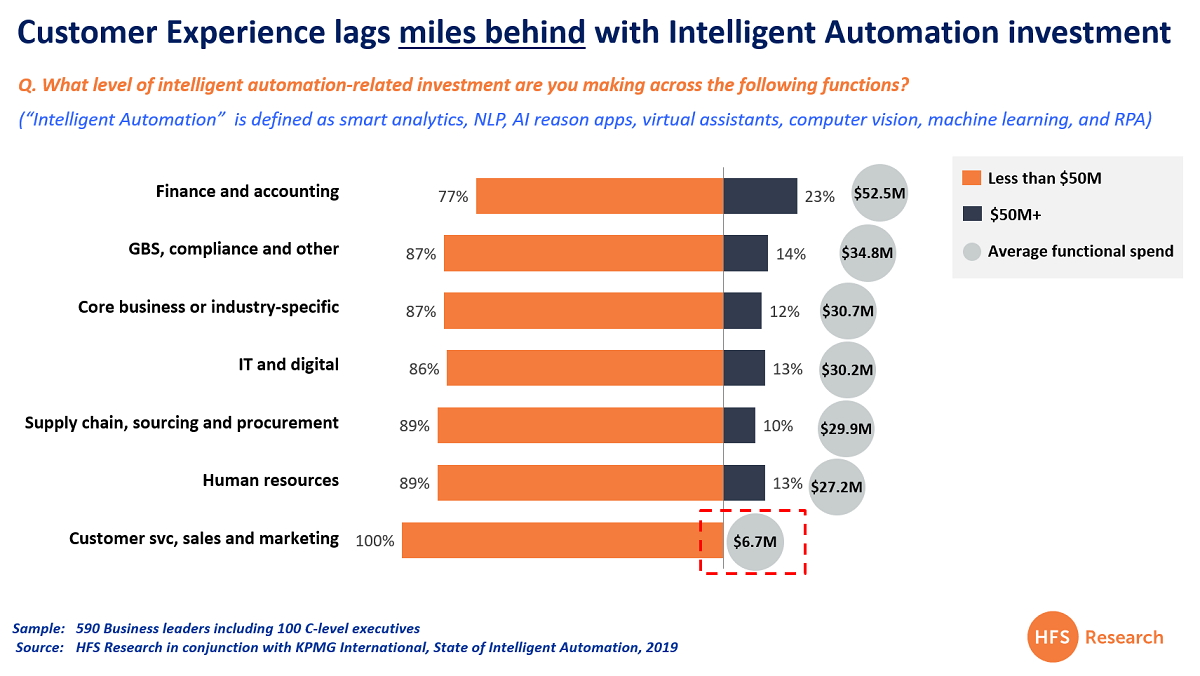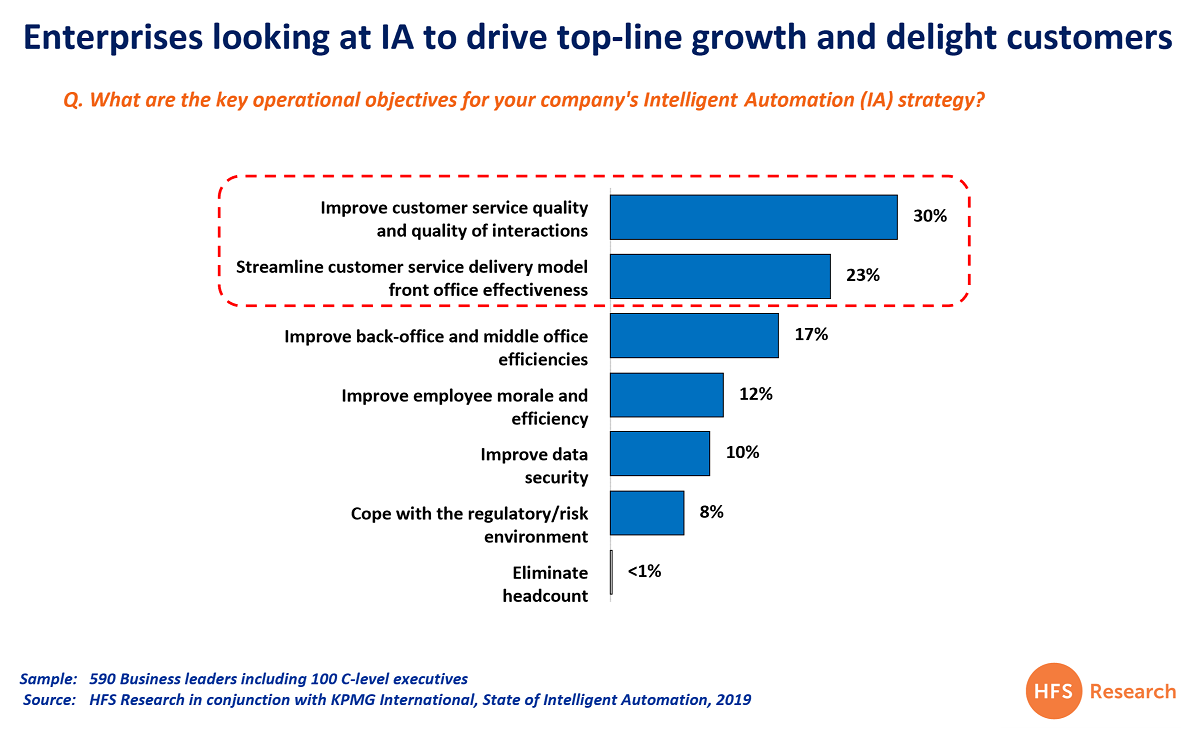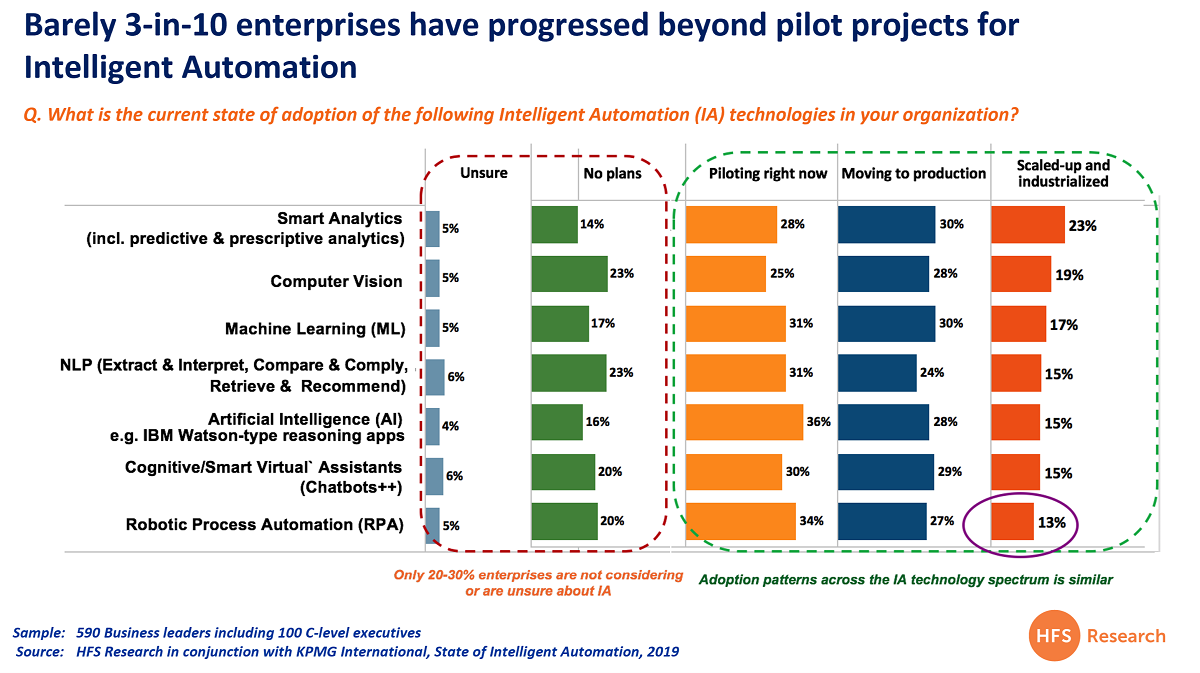After the recent RPA circus acts, the process automation industry has reached its lowest ebb. Simply put, dollars were being put behind a value proposition that simply wasn’t realistic – but that doesn’t mean the market doesn’t have amazing potential. We just need to refocus (and fast) on a direction that is real and sustainable for the long-term and rally everyone behind it. And the fault lies as much with the enterprises buying the solutions as it does those selling and implementing them.
Far too many enterprises are paying lip service to CX – they love to ”big it up” but aren’t putting their money where their mouths are
We can bemoan over-eager investors and over-hyping marketeers all day long for over-cooking the market, but the reality behind the sluggish uptake of scaled deployments is the simple fact that intelligent automation initiatives and investments are firmly rooted in the back office, according to 590 major global enterprises, where nine times as much investment has gone into the back office versus the front:
So why is such paltry investment being made in the front office, when improving the customer experience and making front office function more efficiently are the biggest drivers? Is the CMO/CDO completely distrusted to spend on technology-enabled initiatives? Is automation simply an activity not worthy of the CMO’s attention and the CFO has to be the one to get his/her hands dirty? Because when you talk to digital leaders on both the buy and sell-side of the equation, they will all confess that both the potential and capability of RPA to fix the gargantuan mess that is marketing and customer service process is massive. Yes indeed people, improving customer experience is the ultimate objective of the majority of enterprises’ intelligent automation strategies. Because you can’t get the full benefit from customer analytics and AI if your processes are glued together by spaghetti code and manual workarounds:
Adoption of intelligent automation solutions is painfully slow because enterprises are failing to define their ideal “to-be” states
When you consider it took a decade just for the finance function to grapple with the seismic shift from Lotus 1-2-3 to Excel, why are we expecting the same people to embrace much more complex technology tools like RPA and Watson as voraciously as ice cream ion a hot summer’s day? Sure, the levels of investment in intelligent automation have already surpassed an average of $50m for the function, but the pace of adoption is still desperately slow, with barely a third of enterprises moving beyond pilots for any Intelligent Automation technology:
The Bottom-line: The process automation industry needs to rebuild the trust of enterprise leaders and investors. That means we need to approach this from an enterprise-wide perspective and quit paying lip-service to the customer experience
The only way to focus on successful automation is for clients to define their ideal “to be” state and then work on solutions to help them get there. For many enterprises, this may be to drive down cost / improve efficiency, but the majority are focused on improving customer interactions and customer delivery execution (see above).
What software vendors need to do: Quit all the marketing fluff and focus your solutions on supporting clients reaching their desired “to-be” states. Just trying to sell licenses as aggressively as possible has only resulted in mass disappointment – and has hurt the market and lost a lot of customer trust. Who cares which brand came higher in the latest analyst report (written by some analyst who has never written a script in his life) or whether Microsoft actually has any clue what it’s doing, making a play into this space with some dated technology? Instead, focus on engaging customers to solve their desires – which are clearly outlined above. This means making sure you have evangelists who can educate clients (not just amplify the same old cardboard marketing fluff from some turgid conference) and invest in a support division which can build a world-class partner ecosystem and support clients directly during their early phases to get this all on the right track. Sure the tech is important, but if it’s not purchased with the right mindset it’s all one big fat waste of time and money – and costs many their careers into the bargain.
What enterprises need to do: Design and define your “to-be state” and use that to flesh out which partners can actually listen, understand and deliver. The first thing you need to do is get past all this “bot for every employee” nonsense and focus on what you need, not how many licenses to buy to keep your local RPA sales rep happy. Most of these products can deliver basic RPA, document processing, screen scraping etc (and you can get deeper into which one performs best to meet your need in time), but you really need to get familiar with the whole concept and potential of intelligent automation technologies before throwing wads of cash at new kit. I’ve already seen several people lose their jobs because they squandered fortunes on licenses they didn’t need and were left carrying the can for a dog’s breakfast of an automation program… Then you need to explore all your critical process flows across the front-to-back offices. While your operations folks in the non-customer facing areas will undoubtedly be more enthusiastic about develop competencies in intelligent automation, getting the frost office executives on board will reap considerable benefits down the road, Marketing workflows are awash with manual workarounds, legacy apps and silos of data… customer services are a real mixed back of good and bad process habit and don’t even get me started on sales. So think OneOffice… think about how the real customer-centric organization needs to operate and you can work backward from there.
What service providers and consultants need to do: get your heads out of the back office and reel in the marketing/sales leads. Simply put, you need to be the vehicle to help your enterprise clients align effectively with what the software vendors are selling. If you are not that vehicle then get out now, as you will be dead in the water. While the CFO and COO (and often the CIO) have budget to spend on software-driven process initiatives, they are often too rooted in stove-piped projects which operate at a snail’s pace with little enterprise impact. You need to drive the intelligent automation discussion with the Chief Digital Officer / CMO to understand, listen and demonstrate the huge impact that these technologies can have in enabling a well-designed customer process and integrating with the operational areas of the firm to support unified data efforts. You have to help join the front and back-office pieces together for your clients if they are ever going to get past task optimization to genuine end-to-end process automation.
Posted in : Artificial Intelligence, intelligent-automation, OneOffice, Robotic Process Automation









I’ve been saying this for ages Phil – which is why to date the vast amount of our processes have been aimed at improving patient outcomes (our customers). Perhaps for some organisations it is a confidence thing or maybe the people advising them find comfort in targeting generic back office functions because they lack sector specific knowledge and experience?!?
Hi Phil our research at Ovum into digital transformation progress over the last 3 years involving around 5k enterprises each year backs up your conclusions as the least developed – omnichannel customer engagement appears to be going backwards.
Jeremy
Well to be fair, this is mostly because the robotic bit led and hence most initiatives started with robotic type jobs/roles/functions …aka back office…customer journeys can and are being improved and re-imagined leveraging intelligent automation…there are many examples. Uber, is an obvious one of many who have completely changed how you hire/buy something using automation, integrated with IoT. I guess many of us just have been focussing elsewhere on the robotic bit and the independent vendors who provide the robots. Meanwhile, the really interesting stuff is being built and launched by the business platform providers themselves…with no automation vendors getting a mention…does Uber use one of the top rpa vendors in their ride hailing app architecture? Probably not. Does Uber’s automated/self service app also work in say Banking…nope . Customer journey automation is totally bespoke and aligned to the product/service being sold…no off the shelf software can meet the need on its own…it is a complex eco system designed for one job only…in this example taxi ride hailing..
As many people know, I like to say what I really think and give credit where credit is due. Phil, SPOT on.
There are those who peddle the hype and those who are doing. They both need to take a step closer to each other in my view.
It must be said that the back-office processes also improve customer experience.
Very good data. Another perspective of it, “Intelligent automation started off with back office processes and now moving to the front office.” And boy, it’s moving rapidly!
Phil Fersht hits the bullseye with this quote from this article. Every RPA vendor should take this to heart. Great job Phil!
The B2C’s are already doing it. Just try calling the Insurance/Bank/HMRC helpline and you get a bot. It’s a very different story for the blue chip B2B businesses though. They are more afraid of damage to their reputation if the customers don’t like the experience. And the CFOs will be wanting to see the back office automation succeed before risking the customer processes. And as the article points out, these results have been disappointing for so many reasons. One is the caution used and not wholly embracing the full automation opportunity. It’s hard to make piecemeal pay off.